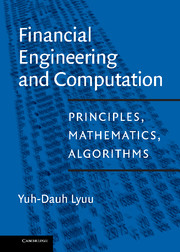Book contents
- Frontmatter
- Contents
- Preface
- Useful Abbreviations
- 1 Introduction
- 2 Analysis of Algorithms
- 3 Basic Financial Mathematics
- 4 Bond Price Volatility
- 5 Term Structure of Interest Rates
- 6 Fundamental Statistical Concepts
- 7 Option Basics
- 8 Arbitrage in Option Pricing
- 9 Option Pricing Models
- 10 Sensitivity Analysis of Options
- 11 Extensions of Options Theory
- 12 Forwards, Futures, Futures Options, Swaps
- 13 Stochastic Processes and Brownian Motion
- 14 Continuous-Time Financial Mathematics
- 15 Continuous-Time Derivatives Pricing
- 16 Hedging
- 17 Trees
- 18 Numerical Methods
- 19 Matrix Computation
- 20 Time Series Analysis
- 21 Interest Rate Derivative Securities
- 22 Term Structure Fitting
- 23 Introduction to Term Structure Modeling
- 24 Foundations of Term Structure Modeling
- 25 Equilibrium Term Structure Models
- 26 No-Arbitrage Term Structure Models
- 27 Fixed-Income Securities
- 28 Introduction to Mortgage-Backed Securities
- 29 Analysis of Mortgage-Backed Securities
- 30 Collateralized Mortgage Obligations
- 31 Modern Portfolio Theory
- 32 Software
- 33 Answers to Selected Exercises
- Bibliography
- Glossary of Useful Notations
- Index
26 - No-Arbitrage Term Structure Models
Published online by Cambridge University Press: 19 September 2009
- Frontmatter
- Contents
- Preface
- Useful Abbreviations
- 1 Introduction
- 2 Analysis of Algorithms
- 3 Basic Financial Mathematics
- 4 Bond Price Volatility
- 5 Term Structure of Interest Rates
- 6 Fundamental Statistical Concepts
- 7 Option Basics
- 8 Arbitrage in Option Pricing
- 9 Option Pricing Models
- 10 Sensitivity Analysis of Options
- 11 Extensions of Options Theory
- 12 Forwards, Futures, Futures Options, Swaps
- 13 Stochastic Processes and Brownian Motion
- 14 Continuous-Time Financial Mathematics
- 15 Continuous-Time Derivatives Pricing
- 16 Hedging
- 17 Trees
- 18 Numerical Methods
- 19 Matrix Computation
- 20 Time Series Analysis
- 21 Interest Rate Derivative Securities
- 22 Term Structure Fitting
- 23 Introduction to Term Structure Modeling
- 24 Foundations of Term Structure Modeling
- 25 Equilibrium Term Structure Models
- 26 No-Arbitrage Term Structure Models
- 27 Fixed-Income Securities
- 28 Introduction to Mortgage-Backed Securities
- 29 Analysis of Mortgage-Backed Securities
- 30 Collateralized Mortgage Obligations
- 31 Modern Portfolio Theory
- 32 Software
- 33 Answers to Selected Exercises
- Bibliography
- Glossary of Useful Notations
- Index
Summary
The fox often ran to the hole by which they had come in, to find out if his body was still thin enough to slip through it.
The Complete Grimm's Fairy TalesThis chapter samples no-arbitrage models pioneered by Ho and Lee. Some of the salient features of such models were already covered, if implicit at that, in Chap. 23.
Introduction
Some of the difficulties facing equilibrium models were mentioned in Section 25.4. For instance, they usually require the estimation of the market price of risk and cannot fit the market term structure. However, consistency with the market is often mandatory in practice [457]. No-arbitrage models, in contrast, utilize the full information of the term structure. They accept the observed term structure as consistent with an unobserved and unspecified equilibrium. From there, arbitrage-free movements of interest rates or bond prices over time are modeled. By definition, the market price of risk must be reflected in the current term structure; hence the resulting interest rate process is risk-neutral.
No-arbitrage models can specify the dynamics of zero-coupon bond prices, forward rates, or the short rate [477, 482]. Bond price and forward rate models are usually non-Markovian (path dependent), whereas short rate models are generally constructed to be explicitly Markovian (path independent). Markovian models are easier to handle computationally than non-Markovian ones.
Exercise 26.1.1 Is the equilibrium or no-arbitrage model more appropriate in deciding which government bonds are overpriced?
The Ho–Lee Model
This path-breaking one-factor model enjoys popularity among practitioners [72]. Figure 26.1 captures the model's short rate process. The short rates at any given time are evenly spaced.
- Type
- Chapter
- Information
- Financial Engineering and ComputationPrinciples, Mathematics, Algorithms, pp. 375 - 398Publisher: Cambridge University PressPrint publication year: 2001



